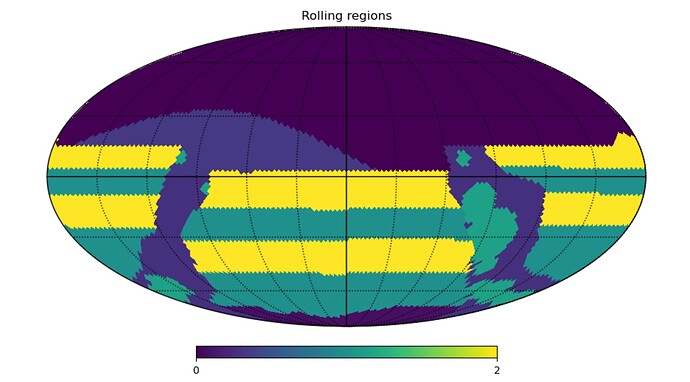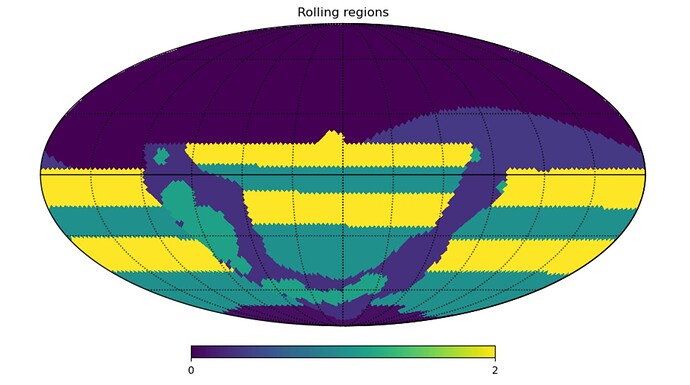Hi Chris!
The footprint has 2 ‘active’ rolling regions (when rolling is ongoing) and 2 ‘inactive’ regions – these regions alternate during the period rolling is ongoing. Each of these regions is actually compromised of two different declination bands, to avoid putting too much Rubin coverage toward the north or south of the footprint at one time. The exact location of these declination bands depends on the RA of interest, as we define them based on the area in the survey footprint that should be rolling (we want to make this area equal between the different regions) … plus the declination bounds for the low-dust WFD portion of the survey vary slightly depending on RA (primarily it is positioned slightly further north at positive galactic latitudes, and further south at negative galactic latitudes).
Anyway, the result is that we have bands that look like this (from two different directions)
and can be very approximately defined as
dec_bands_S = [2.4, -16, -33, -50]
dec_bands_N = [15, 5, -10, -25]
(for the “south” / negative galactic longitude region, and the “north” / positive galactic longitude region).
When you say “what are the start and end dates for the rolling season” – I’m not entirely sure what you’re meaning here. There is a start and end date of when rolling starts or ends, but there are obviously a lot of different seasons of rolling (each of these declination bands has about 4 seasons of ‘more active’ rolling and 4 seasons of ‘less active’ rolling … and moreover, the choice of whether rolling is ‘active’ or ‘inactive’ at any given point depends on the RA of the point on the sky. Some of the plots in PSTN-052 may be helpful for this, showing how at different RA and Dec values the footprint (which goes into requesting observations) can be ramping up or staying relatively flat. As such, this is pretty difficult to answer in a simple but meaningful way.
Currently, we are starting to add rolling bands into the target footprints at around 1.5 years after the start of the survey, and use the bands that look “green” in the plots above first (at year 2.5, the “yellow” bands would be the active bands, and so on). Because of how the various parts of the sky start and stop rolling, the rolling footprint continues on some parts of the sky into the last year and it only becomes completely flat at something like 0.5 years before the end of the survey (note that these are the footprint target maps input to the scheduler, and not the final result of observations coming out of the scheduler … which are also influenced by other considerations - there certainly are some benefits to looking at the actual simulation outputs for timing of observations).
Your last question about whether the footprints are fixed at this stage is really a question about future SCOC choices. However, previous announcements from the SCOC about survey strategy have indicated that the general low-dust WFD footprint is fairly fixed; the galactic plane footprint is not. The details of how rolling cadence is implemented are likely not entirely fixed; there will be some kind of rolling cadence, with something like the scaling up/down (to impact the cadence of visits within each of these regions) that we have now - but the timing of the rolling may be tweaked still and depending on changes in the galactic plane footprint and whether this footprint is also part of the general rolling, will also influence the details of these rolling bands.
Hope this helps, Lynne

